
Marion Square is greenspace in downtown Charleston, South Carolina, spanning six and one half acres. The square was established as a parade ground for the state arsenal under construction on the north side of the square. It is best known as the former Citadel Green because The Citadel occupied the arsenal from 1843 until 1922, when the Citadel moved to the city's west side. Marion Square was named in honor of Francis Marion.

Johnson Hagood Stadium, is an 11,500-seat football stadium, the home field of The Citadel Bulldogs football team, in Charleston, South Carolina, United States. The stadium is named in honor of Brigadier General Johnson Hagood, CSA, class of 1847, who commanded Confederate forces in Charleston during the Civil War and later served as Comptroller and Governor of South Carolina.

The Cathedral of St. John the Baptist is the mother church of the Roman Catholic Diocese of Charleston, located in Charleston, South Carolina. Designed by Brooklyn architect Patrick Keely in the Gothic Revival style, it opened in 1907. The Most Reverend Jacques E. Fabre, the fourteenth Bishop of Charleston, was ordained and installed on May 13, 2022

St. Peter is one of the four main churches of the old town of Zürich, Switzerland, besides Grossmünster, Fraumünster, and Predigerkirche.

The City Market is a historic market complex in downtown Charleston, South Carolina. Established in the 1790s, the market stretches for four city blocks from the architecturally-significant Market Hall, which faces Meeting Street, through a continuous series of one-story market sheds, the last of which terminates at East Bay Street. The market should not be confused with the Old Slave Mart where enslaved people were sold, as enslaved people were never sold in the City Market. The City Market Hall has been described as a building of the "highest architectural design quality." The entire complex was listed on the National Register of Historic Places as Market Hall and Sheds and was further designated a National Historic Landmark.
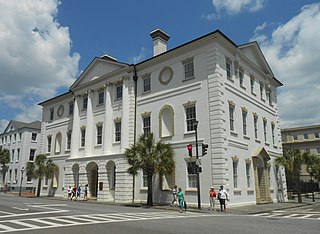
Charleston Library Society, founded in 1748, is a subscription library in Charleston, South Carolina.

St. Michael's Episcopal Church, Parish House and Rectory is a group of architecturally-significant religious buildings located at 200-216 North Mill Street in Birdsboro, Berks County, Pennsylvania. It was added to the U.S. National Register of Historic Places in 1982.

The Metropolitan Cathedral of Saint John the Baptist of Badajoz is a Catholic cathedral in Badajoz, Extremadura, western Spain. Since 1994, together with the Co-cathedral of Saint Mary Major of Mérida, it is the seat of the Archdiocese of Mérida-Badajoz.

The German Evangelical Lutheran Church of Charleston, South Carolina, was incorporated on December 3, 1840. Through usage and custom the Church is now known as St. Matthew's German Evangelical Lutheran Church or St. Matthew's Lutheran Church and is a member of the South Carolina Synod of the Evangelical Lutheran Church in America.

Albert Wheeler Todd was an architect in Charleston, South Carolina. He is known for his neoclassical architecture, the design on his own home and of a home for Tristram Hyde. Todd was the senior partner at the firm of Todd & Benson which became Todd, Simons & Todd. Joseph F. Leitner worked with him. Todd also served in the legislature from 1910 until 1924 and was a State Senator.
Augustus E. Constantine was an architect in Charleston, South Carolina. He is known for his Art Moderne architecture.
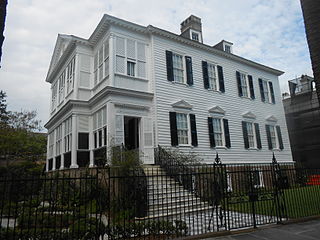
The William Washington House is a pre-Revolutionary house at 8 South Battery, Charleston, South Carolina. It is the only pre-Revolutionary house on Charleston's Battery. Thomas Savage bought the lot at the southwest corner of Church St. and South Battery in 1768 and soon built his house there. The resulting structure is a nationally important, Georgian style, square, wooden, two-story house on a high foundation.

The Francis Marion Hotel is a historic hotel opened in 1924 and located at 387 King St., Charleston, South Carolina. It is one of the tallest buildings in Charleston. The hotel is a member of Historic Hotels of America.
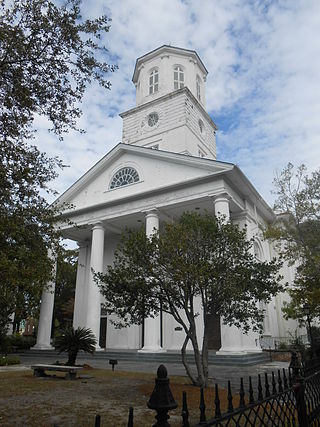
The Second Presbyterian Church is the fourth oldest church in Charleston, South Carolina.

The Richard Brenan House is an early 19th-century house at 207 Calhoun St., Charleston, South Carolina. The house was built for Richard Brenan, a merchant, in 1817 and originally included the adjacent land to the west. The house is a three-story Charleston single house with quoins and fine cornice. The house was a two-story piazza on the west side.
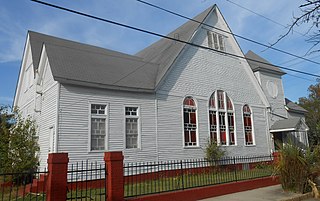
The Emma Abbott Memorial Chapel is a late Victorian church located at 52 Cooper St., Charleston, South Carolina. On October 4, 1890, the Citadel Square Baptist Church bought a parcel at the northwest corner of Cooper and America Streets for the construction of a mission church serving the Eastside. The land was marshy and had to be filled at a cost of $1500. In January 1891, Citadel Square Church learned that it had been named as one of several beneficiaries of the estate of Emma Abbott, a popular opera singer. She had attended church at Citadel Square Church during trips to Charleston in 1880, 1886, and February 1888.
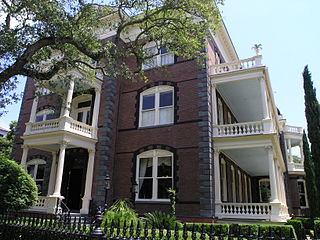
The Williams Mansion is a Victorian house at 16 Meeting St., Charleston, South Carolina. The mansion is open for public tours.
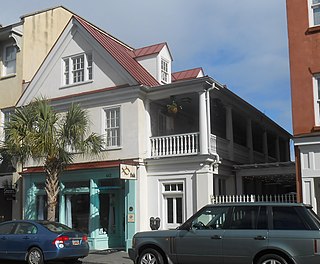
The James Ferguson House at 442 King St., Charleston, South Carolina, is an antebellum house dating to at least 1840. As of 2000 it was being used as a restaurant.

Padgett-Thomas Barracks is the dominant building on the campus of The Citadel in Charleston, South Carolina. Constructed from 1920 to 1922 as the first building on The Citadel's new site but demolished and replaced from 2000 to 2004, the barracks serves as the living quarters for up to 560 members of the South Carolina Corps of Cadets. The eight-story tower which distinguishes it from the other four, smaller, barracks on Campus of The Citadel is also styled as a brand mark of the military college.
The architecture of Charleston, the largest city in the US state of South Carolina, has English and Barbadian influences.


















